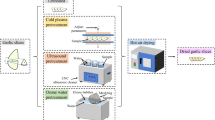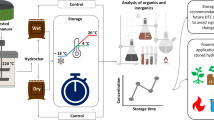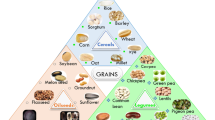Abstract
The aim of this work was to determine the mass transfer properties of pumpkin (Cucurbita moschata) exposed to air drying. The drying temperatures tested ranged between 30°C and 70°C, and the kinetic behavior was studied in this temperature band. The samples were analyzed in terms of moisture content, acidity, proteins, lipids, and crude fiber, both in the fresh state and after drying. From the chemical analyses made, it was possible to conclude that drying induces some reductions in acidity, lipids, fibers, and proteins. As to the influence of the drying temperature on the process, it was observed that a temperature rise from 30°C to 70°C led to a 70% saving in drying time. The results obtained by fitting the experimental data to the kinetic models tested allowed concluding that the best model for the present case is Henderson–Pabis, and the worst is Vega–Lemus. Furthermore, in this work, it was possible to determine the values of the diffusion coefficient at an infinite temperature, D 0e , and activation energy for moisture diffusion, E d, which were, respectively, 0.0039 m2/s and 32.26 kJ/mol. Similarly, the values of the Arrhenius constant and the activation energy for convective mass transfer, respectively, h 0m and E c, were also calculated, the first being 3.798 × 108 m/s and the latter 86.25 kJ/mol. These results indicate that the activation energy for convective mass transfer is higher than that for mass diffusion.







Similar content being viewed by others
References
Akpinar, E. K. (2006). Determination of suitable thin layer drying curve model for some vegetables and fruits. Journal of Food Engineering, 73, 75–84.
Al-Harahsheh, M., Al-Muhtaseb, A. H., & Magee, T. R. A. (2009). Microwave drying kinetics of tomato pomace: Effect of osmotic dehydration. Chemical Engineering and Processing, 48(1), 524–531.
Alibas, I. (2007). Microwave, air and combined microwave-air-drying parameters of pumpkin slices. LWT, 40(8), 1445–1451.
AOAC (Association of Official Analytical Chemists) (1990) Official methods of analysis, 15th ed. Arlington
Arévalo-Pinedo, A., & Murr, F. E. X. (2006). Kinetics of vacuum drying of pumpkin (Cucurbita maxima): Modelling with shrinkage. Journal of Food Engineering, 76, 562–567.
Crank, J. (1970). The mathematics of diffusion. London: Oxford University Press.
Crank, J. (1975). The mathematics of diffusion (2nd ed.). London: Oxford University Press.
Díaz, E. L., Giannuzzi, L., & Giner, S. A. (2009). Apple pectic gel produced by dehydration. Food and Bioprocess Technology, 2(2), 194–207.
Doymaz, I. (2007). The kinetics of forced convective air-drying of pumpkin slices. Journal of Food Engineering, 79, 243–248.
Dutta, D., Dutta, A., Raychaudhuri, U., & Chakraborty, R. (2006). Rheological characteristics and thermal degradation kinetics of beta-carotene in pumpkin puree. Journal of Food Engineering, 76, 538–546.
Faustino, J. M. F., Barroca, M. J., & Guiné, R. P. F. (2007). Study of the drying kinetics of green bell pepper and chemical characterization. Food and Bioproducts Processing, 85(C3), 163–170.
Krokida, M. K., Karathanos, V. T., & Maroulis, Z. B. (2003). Drying kinetics of some vegetables. Journal of Food Engineering, 59, 391–403.
Lahsasni, S., Kouhila, M., Mahrouz, M., & Jaouhari, J. T. (2004). Drying kinetics of prickly pear peel (Opuntia ficus indica). Journal of Food Engineering, 61, 173–179.
Lee, J. H., & Kim, H. J. (2009). Vacuum drying kinetics of Asian white radish (Raphanus sativus L.) slices. LWT - Food Science and Technology, 42(1), 180–186.
Roberts, J. S., Kidd, D. R., & Padilla-Zakour, O. (2008). Drying kinetics of grape seeds. Journal of Food Engineering, 89(4), 460–465.
Ruiz-López, I. I., Castillo-Zamudio, R. I., Salgado-Cervantes, M. A., Rodríguez-Jimenes, G. C., & García-Alvarado, M. A. (2009). Mass transfer modeling during osmotic dehydration of hexahedral pineapple slices in limited volume solutions. Food and Bioprocess Technology. doi:10.1007/s11947-008-0102-x.
Sacilik, K. (2007). Effect of drying methods on thin-layer drying characteristics of hull-less seed pumpkin (Cucurbita pepo L.). Journal of Food Engineering, 79, 23–30.
Shittu, T. A., & Raji, A. O. (2009). Thin layer drying of African breadfruit (Treculia africana) seeds: Modeling and rehydration capacity. Food and Bioprocess Technology. doi:10.1007/s11947-008-0161-z.
Togrul, I., & Pehlivan, D. (2003). Modelling of drying kinetics of single apricot. Journal of Food Engineering, 58(3), 23–32.
Tripathy, P. P., & Kumar, S. (2009). A methodology for determination of temperature dependent mass transfer coefficients from drying kinetics: Application to solar drying. Journal of Food Engineering, 90(2), 212–218.
Uribe, E., Vega-Gálvez, A., Di Scala, K., Oyanadel, R., Torrico, J. S., & Miranda, M. (2009). Characteristics of convective drying of pepino fruit (Solanum muricatum Ait.): Application of Weibull distribution. Food and Bioprocess Technology. doi:10.1007/s11947-009-0230-y.
Vega, A., Fito, P., Andrés, A., & Lemus, R. (2007). Mathematical modeling of hot-air drying kinetics of red bell pepper (var. Lamuyo). Journal of Food Engineering, 79, 1460–1466.
Vega-Gálvez, A., Andrés, A., Gonzalez, E., Notte-Cuello, E., Chacana, M., & Lemus-Mondaca, R. (2009). Mathematical modelling on the drying process of yellow squat lobster (Cervimunida jhoni) fishery waste for animal feed. Animal Feed Science and Technology, 151, 268–279.
Yaldýz, O., & Ertekýn, C. (2001). Thin layer solar drying of some vegetables. Drying Technology, 19(3), 583–597.
Yang, H., Sakai, N., & Watanabe, M. (2001). Drying model with non-isotropic shrinkage deformation undergoing simultaneous heat and mass transfer. Drying Technology, 19(7), 1441–1460.
Author information
Authors and Affiliations
Corresponding author
Rights and permissions
About this article
Cite this article
Guiné, R.P.F., Henrriques, F. & João Barroca, M. Mass Transfer Coefficients for the Drying of Pumpkin (Cucurbita moschata) and Dried Product Quality. Food Bioprocess Technol 5, 176–183 (2012). https://doi.org/10.1007/s11947-009-0275-y
Received:
Accepted:
Published:
Issue Date:
DOI: https://doi.org/10.1007/s11947-009-0275-y




